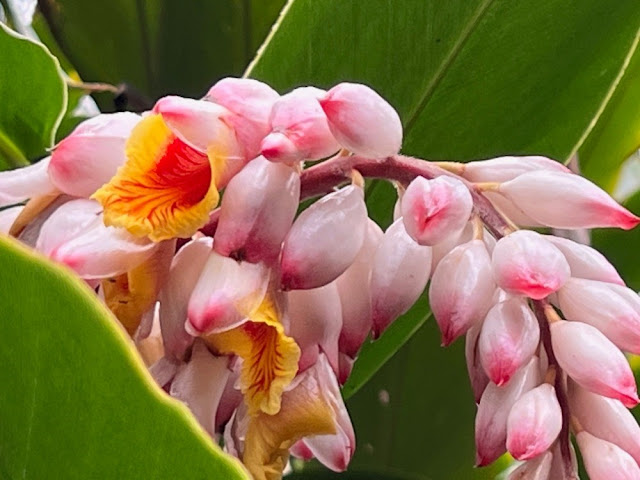On Tuesday, January 24th, we visited two more of the three National Tropical Botanical Gardens on Kauai--Allerton and McBryde. As with Limahuli, advance reservations were required, and we drove leisurely over from Kapa'a to nearly Poipu, where the gardens can be found adjacent to the sea.
No visit to Kaua'i is complete without including these lovely national tropical gardens. The Allerton and McBryde gardens in the Lawa’i valley have a complex history interwoven with the colonization of the Hawaiian islands, and commercial sugar cane agricultural operations. The site in the Lawa’i Valley was granted to James Young Kanehoa, the son of John Young, an advisor to Hawaii’s King Kamehameha I, in 1848. Kanehoa subsequently willed a third of the land to his niece, Queen Emma and she received the rest of it in 1885 from Kanehoa’s widow, Hikoni. Queen Emma first visited the Lawa’i valley on a tour of the kingdom with her husband Liholiho, King Kamehameha IV but eventually returned to live in the valley after the death of her husband and young son. Her neighbors included the McBryde family, who grew sugar cane and ultimately leased the Lawa’i Valley from Queen Emma, who reserved for herself the cottage and surrounding land. They purchased the property outright from her estate in 1886. The upper valley was intensively cultivated in sugar cane, while taro and rice were grown in the lower portion by tenant farmers. In 1899 the lower valley was conveyed to Alexander McBryde.
Mouth of Lawai'i Stream
McBryde added to Queen Emma’s plantings of rose apples, Alexandrian laurel, mangoes, bamboo, pandanus, ferns, and bougainvillea by planting palms, gingers, plumerias, and ferns in gardens along the beach. Then, in 1938 McBryde sold the property to Robert Allerton. Allerton was an avid art collector and patron, and also was intrigued by landscape architecture of formal gardens and settings for statues, which he pursued first at “The Farms” in Monticello, Illinois. It was in Illinois that Allerton met John Gregg, a young architectural student at the University of Illinois, The Allertons visited Kaua’i and the lower portion of the Lawa’i Valley, and subsequently purchased the property, moving into a new home in the valley designed by John Gregg.
Robert Allerton and John Gregg immediately began designing and laying out the gardens, continuing to include exotic plants as Alexander McBryde had done earlier. They enlarged the gardens with plants they collected in Southeast Asia and the Pacific and introduced classic statuary which they collected.
In the 1960s Robert Allerton joined with a group of organizations and individuals committed to establishing a tropical botanical garden for the United States. Together they petitioned Congress and in 1964, the last year of Robert Allerton’s life, the charter was granted to establish the Pacific Tropical Botanical Garden. When he died, the Allerton Garden Trust held the land and part of the conditions for the Trust was that only guided tours (no self-guided) could occur on the Allerton Gardens. Robert also left an outright monetary gift to the Trust, which made it possible the purchase of land adjacent to the Allerton Garden, which became known as the McBryde Garden, which can include self-guided tours. The National Tropical Botanical Garden formally assumed management of the Allerton Garden for the Allerton Gardens Trust in the early 1990s.
Visiting the gardens allows you to see where famous scenes from Jurassic Park and other movies were filmed, as well as observe wildlife throughout the gardens. such as the frogs in the old coal storage area and herons along the valley stream.










No comments:
Post a Comment